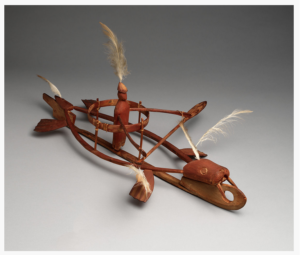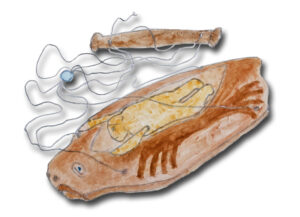In this blog we will travel to the frozen Arctic Zone of North America where the Inuit lived. The Yup’ik speakers of Western Alaska still use mechanical figures. Ceremonies were held to celebrate important occasions and to ensure successful hunting.
I found it fascinating that the ancient Native American Nations utilized puppets/puppetry in their religious ceremonies long before Europeans showed up. In 1842, a Russian navy lieutenant saw puppets near St. Michael, Alaska being used in a village ceremony. There were owls with flapping wings, gulls diving for fish and ptarmigans pecking each other. Witnesses tell about a room that was illuminated with oil lamps and candles where figures shaped like humans moved, talked and even walked across the room.
Inuit Shamans would use masks in certain ceremonies in conjunction with wooden puppets in ways that would entertain or frighten participants.
Dance Object or Puppet?

This “dance object” may qualify as a puppet. Experts are divided about what distinguishes an object as a dance object or a puppet. A lot of knowledge has been lost, so we can only speculate about how an object was actually used. This object was collected along the Kuskokwim River in early 1905. It hung from the roof of a ceremonial house and honored the animals taken in the hunt. A male figure wears a traditional Yup’ik bentwood hunting hat and pilots a magical kayak disguised as a walrus — the head, tail, and flippers of the creature are visible. It is 17 3/4 x 24 24 3/4 x 36 in. so it’s pretty good sized. It is made from wood, pigment, vegetal fiber and feathers.
Another ceremony involves a large, carved mask of a salmon hanging from the rafters while dancers moved behind it. Carvings of full body whales were worn on vertical masks. A 5’x5′ loon had a dancer moving in the middle of the suspended “mask.” This mask could be considered a full body puppet. There were small masks on the fingertips of dancing women. These small masks could be considered as finger puppets.
Effigy Puppet

This is an artist’s rendition of the “Effigy Puppet” from the Collection at the Michael C. Rockefeller Wing at The Met, NY. It is no longer available to view. The size of the original puppet is H 15 1/2 inches x W 3 1/2 inches. It is made from wood, shell, commercial cord and pigment. This could possibly qualify as a string puppet since it has a controller with strings and is the perfect size and configuration to be used by a person. It depicts a man on the back of a walrus.
It kind of makes me wonder why the original artist created it and how this puppet was actually used. What story would it tell?
Source: World Encyclopedia of Puppetry Arts
